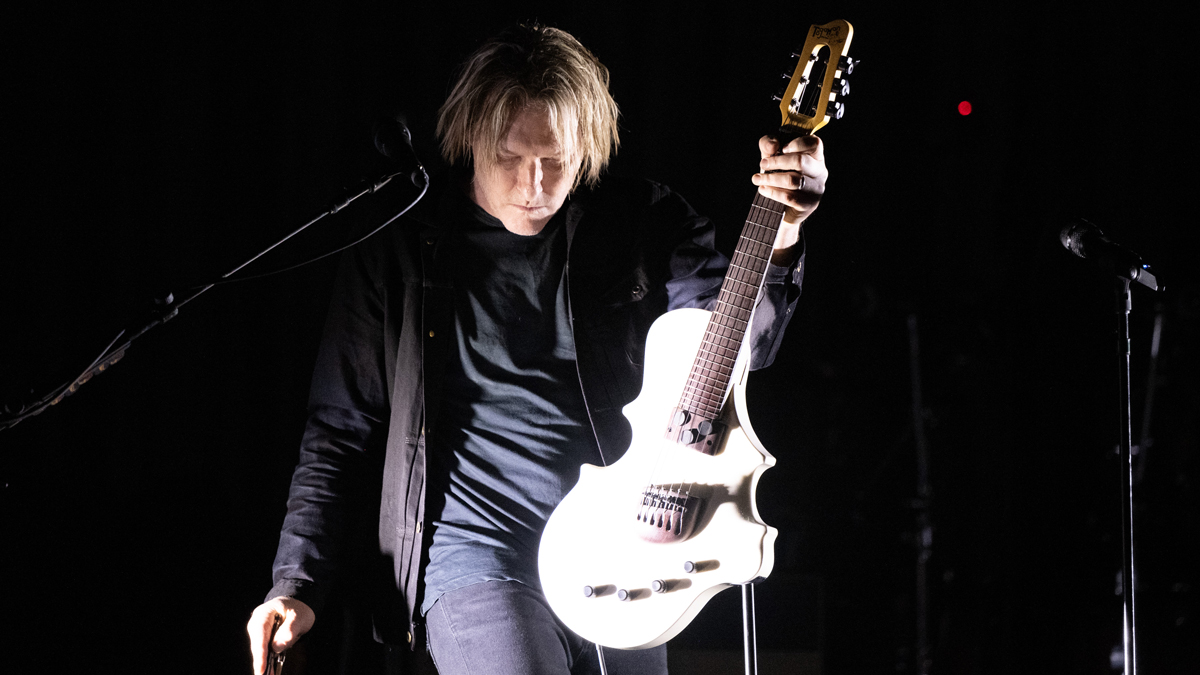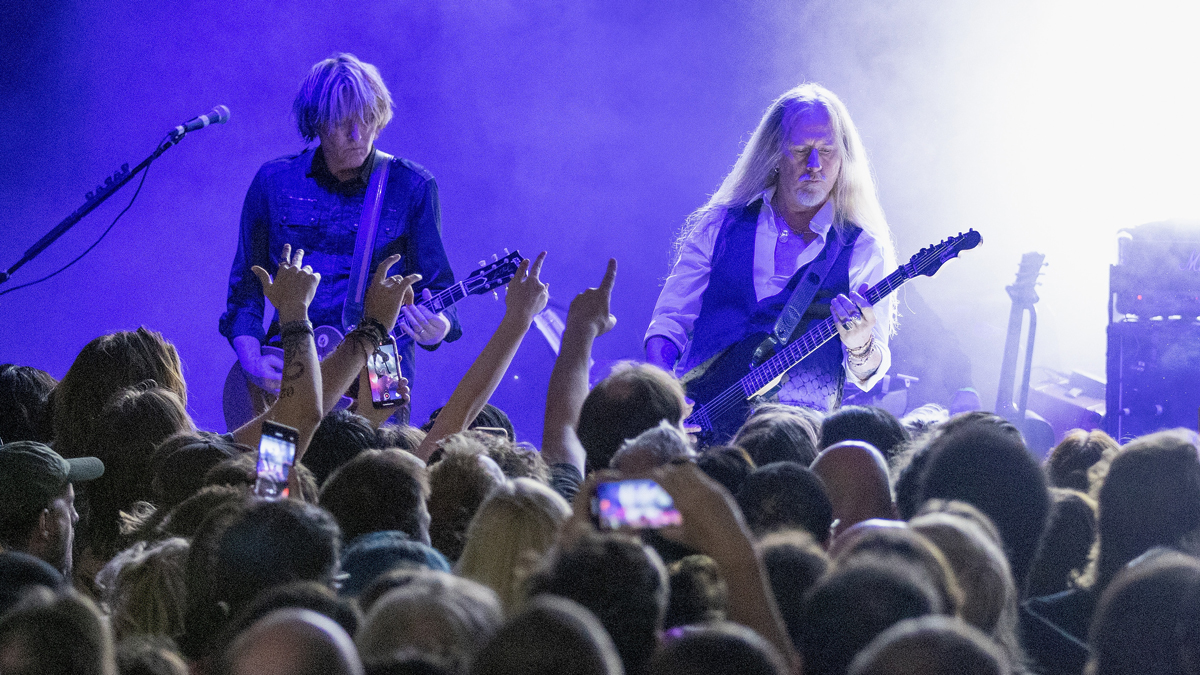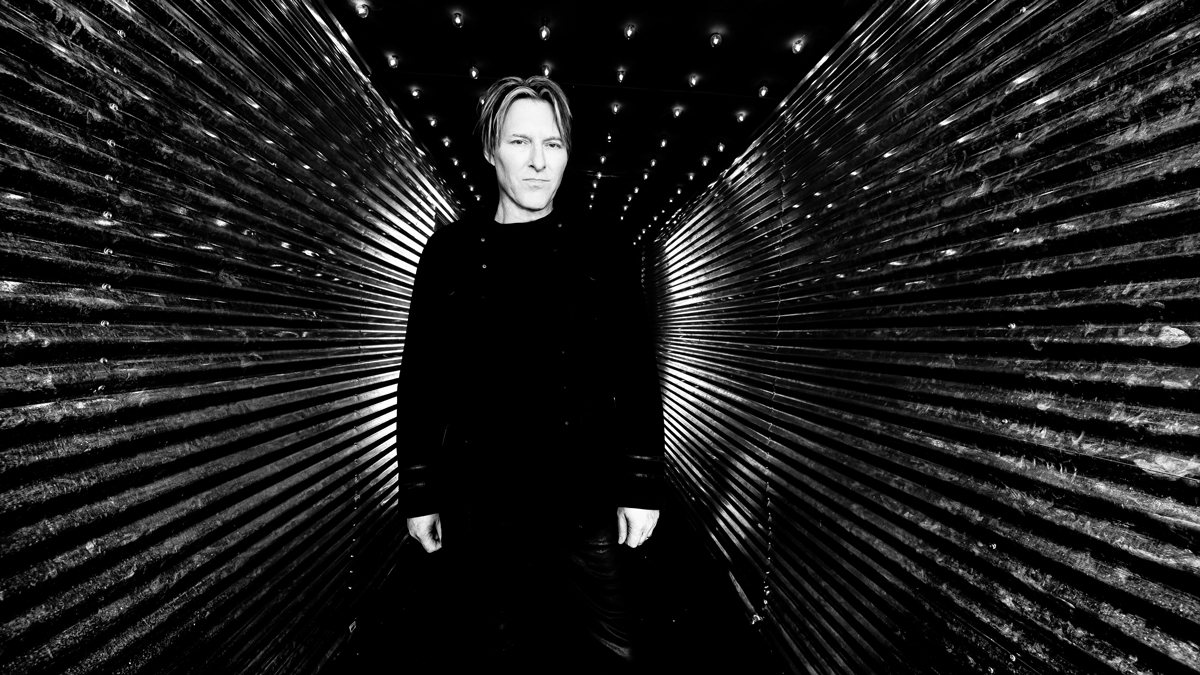Tyler Bates talks recording and touring with Jerry Cantrell, and how the GuitarViol became a "primary color instrument" for his movie work
The prolific composer and guitarist on scoring 300, working with Rob Zombie, and tipping the hat to David Gilmour on Cantrell's latest solo album, Brighten

Tyler Bates is a wearer of many hats. The LA-based composer and guitarist is arguably best known for his film, television and video game soundtracks, having worked heavily on the music heard in big-budget productions like Guardians of the Galaxy, Conan the Barbarian and John Wick.
He also teamed up with Rob Zombie for The Devil’s Rejects, which quickly became a cult classic for modern-age horror fans following its 2005 release, and partnered up with Hollywood hotshot Zack Snyder on films like Dawn of the Dead and 300. As a musician and producer, he’s collaborated with the likes of Marilyn Manson and, in times more recent, Jerry Cantrell – working on last year’s stunning Brighten solo album as well as touring in the Alice In Chains singer/guitarist’s solo band.
When he begins our conversation by saying he’s “in the process of reorganizing everything – 11 amps and a million pedals” in front of him, we know we’re in for quite the discussion. Naturally, the subject quickly turns to his involvement on Brighten and the gear used by him and Cantrell for the live shows…
“The whole idea began when Jerry and I were performing together at a Grammy party, just the two of us with acoustics,” explains Bates, talking to GW from his home studio, where he’s surrounded by a seemingly endless maze of amps, instruments and pedals.
“I suggested that perhaps it might be time to make another Jerry Cantrell record, as it had been a considerably long while since the previous one. I know Jerry pretty well – he lives across the street from me. We get together, jam and watch football together anyway.
The idea was we’d take our time so that Jerry could say everything he wanted to as an artist and guitar player
“So that conversation turned into me offering to set the whole thing up, bringing in different players to fill the music out with. The idea was we’d take our time so that Jerry could say everything he wanted to as an artist and guitar player, with music that had taken enough time to ferment and develop in the process…”
Perhaps that’s why the record came out sounding just as deliberated and composed as it did loose and free?
Get The Pick Newsletter
All the latest guitar news, interviews, lessons, reviews, deals and more, direct to your inbox!
“We approached it more like spiritual expression. It wasn’t like, ‘Okay, we’re going in to cut all the tracks in however many days, here are all the songs!’ It was more a matter of curating the music with different friends playing on the songs. I believe it ended up being Jerry’s favorite solo record. Nobody had to make that record – it wasn’t anyone’s gig. So that’s why I thought, ‘Let’s take this off the clock, away from a studio with the red light on and the meter running.’ It needed to develop as a conversation or story.
“I refused to play on the record, but he asked me to, so I think I ended up playing a few bars of bass somewhere and threw some heavy chains into a bucket for Atone, but other than that, I really wanted Jerry to handle all the guitar stuff. I’m more of a devil’s advocate or coach. I’d give him a little nudge here and there but it didn’t take much – he’s a phenomenal artist and human being. Our rapport was really natural.
“By the time we did get to the final tracking sessions, the songs had already existed and there was already a relationship between the music and the players from a performance standpoint. It ended up being a very well balanced and very well-realized record that also translates very well live.”
Speaking of Atone, the open C# tuning created a haunting drone that resulted in one of the moodiest tracks on the record…
“It’s an intense track. We knew we wanted it to have a gunslinger vibe, a throwback to Westerns. It’s a song about a lonely or singular individual trying to become a better person. Maybe it’s about experiencing adversity and not becoming jaded. It also served as a great mission statement for the whole record.
“There was no point in Jerry doing a solo record after 19 years and trying to write ‘singles’. We decided to introduce Atone because it encapsulated the record. It was quite a collaborative effort in terms of capturing the guitar sounds. We weren’t sure how to end the song, so that’s when I suggested kicking it up into double time, for a bigger beat. That ended up being a really cool payoff and there’s a cool nod to David Gilmour with the slide guitars at the end. We love that stuff – he’s on both of our lists of very favorite guitarists.”
For the live shows, we noticed you played a lot of the lead parts on tracks like Siren Song and Brighten while Jerry was singing, switching back and forth throughout the set…
We all had an emotional investment because most of us had been involved in the making of this record and even been playing shows together before the record had been conceptualized
“Before we ever seriously focused our energies together musically, we’d just play for fun. I think we’ve become very close friends and gel naturally. It’s not about the parts; it’s more about tapping into the vibe and intent of the parts Jerry wanted to lay down.
“We weren’t trying to be Alice in Chains or anything else. We all had an emotional investment because most of us had been involved in the making of this record and even been playing shows together before the record had been conceptualized. There’s a spiritual connection and a friendship connection. My parts ended up being this hodgepodge of different rhythms and leads. It felt like a lot to internalize at the beginning, but through all my work in film and in different bands, I have this ability to pick things up fast.
“I initially offered to play bass, because for a minute Duff [McKagan] was interested in doing it but then Guns N’ Roses got busy again. So when he pulled out, I told Jerry I’d play bass and he was like, ‘Nah man, you gotta be on guitar!’ So I have to be the other guy on guitar, next to the guitar legend. I’m the guy people don’t want to see playing guitar [laughs]!”
It looked like you were mainly using a Goldtop and 335 through Friedman amps…
“In North America, both Jerry and I played his signature JJ Friedmans. I’ve had one for years. Obviously it was the appropriate sound. I would have brought out a second amp with me but we were a bit limited on what we could take. The majority of the gigs were theaters and clubs, so there wasn’t really space or capacity to be doing that.
“Normally I like to daisy chain a couple of amps together in multiple mono, not stereo. But Jerry’s signature amps sound great – we used them for certain things in the studio, but I have a ton of amps in my studio.
“It throws people, but a lot of the time – like on those Manson records – I like to use a Peavey Classic 410. People would be like, ‘What?!’ But it felt appropriate. I also use that amp for my GuitarViol, for whatever reason it really works with that instrument.”
The GuitarViol is quite a rare instrument to see on stage with a rock band. What was that like?
“I was actually opening the shows with it. Sometimes it would be really good, sometimes it would be whatever! Every night would be improvised, which made it really fun. Jerry gave me a lot of room for that moment in the show. Obviously we understood the reality: the fans were there for Jerry and wanted to see him playing the music.”

So what were your favorite Alice In Chains songs on the setlist?
“I think we ended up playing a total of 41 songs through the tour. It was changing daily. We’d arrive at a venue and sometimes half an hour before soundcheck Jerry might say, ‘Hey, let’s try and knock this one out, see if we can do it today or tomorrow!’ Obviously any of the AIC songs are great. No Excuses always had a great vibe – it was nice to cruise for a minute in the middle of the show like that.
“It was exciting to see how Greg Puciato stepped into those big songs like Would? and Man in the Box. Rooster was always fun to play and because Jerry does a lot of singing on that one, he deferred to me on a lot of the lead color work. Whale & Wasp was cool when we didn’t clam it up too badly. We were flying live – no click tracks or backing tracks.”
What did you end up bringing out with you on the pedalboard?
I love the EarthQuaker Afterneath… I used it a lot with the GuitarViol stuff or anything that felt ethereal and didn’t require a ton of definition
“I have the MXR Super Badass for whenever I needed a lot of distortion. I used an Electro-Harmonix Pitch Fork for some of the color lines on tracks like My Song, Between and even Brighten, just to give this added dimension and top octave feel. I was using an EarthQuaker Sea Machine at one point. I also had one of their flanger pedals for Your Decision and other songs.
“There was a Boss Digital Delay and the EarthQuaker Afterneath… I love that pedal. I used it a lot with the GuitarViol stuff or anything that felt ethereal and didn’t require a ton of definition. I had a Dunlop Cry Baby because Jerry and I wanted our wah sounds to be in-sync for tracks like Rain When I Die. The tones would lock in together.
“I used the EarthQuaker Rainbow Machine and TC Electronic chorus a bit too. I tend not to go too boutique with pedals on the road, unless I can bring three of each pedal because they’re easy to break, but MXR and Boss stuff never breaks! Some of my other favorites are the Cooper FX Generation Loss. That one is pretty warped and it’s an excellent creative tool. I did a track with Health and Chino Moreno [Anti-Life], using it for this haunting, apocalyptic sound… it was a lot of fun.”
Moving into your film work, you’ve done everything from cult underground movies to massive blockbusters with mega budgets. What do you remember about The Devil’s Rejects?
“I really loved working on The Devil’s Rejects. It’s one of my favorite scores that I’ve ever done. I’d known Rob Zombie casually through mutual friends. When he started working on the film, I reached out to see if he needed any help with music.
“Then we met up and he was a bit frustrated regarding the music. He needed quite a lot and there was nothing that he’d heard that seemed to work with the picture. Him and his editor Glenn Garland were doing a ton of experiments but none of it seemed right. So he tasked me with creating this sound that he hadn’t heard yet, that was as primal and fucked-up as he hoped.”
How do you go about impressing someone like Rob Zombie?
“I went away for two or three weeks into my music lab and started some experiments with a longtime collaborator of mine, Wolfgang Matthes, who is a good friend and almost like a mentor to me when it comes to modular synthesis and the potential of sound. That score had a lot of synths and a lot of practical sounds.
“We’d take recordings of someone walking and breathing, and then process that through a Kontakt instrument or EXS24 sampler. They would have natural loops to them and sometimes those loops would become a rhythmical figure in the score as well as maybe something played on the lowest register, to give you that disturbing creep factor. It could even be the same sound functioning in two entirely different ways.
“It was fun to experiment like that, with tonal frequencies that were unsettling. I wasn’t approaching it like, ‘We’re going to scare people!’ but I did feel that I could probably make people feel uncomfortable to heighten what they’re seeing. The whole thing is very uncomfortable. It’s a fantastic film Rob made.”

300 is another famous movie you were heavily involved in – that must have been a blast…
“I must admit, I was ignorant to 300 when Zack Snyder asked me to come over and talk about this new film. We’d already done Dawn of the Dead together. I was like, ‘What’s 300?!’ He was working on a pitch to get the movie made by some studio. He showed me the graphic novel and asked me to write the music for an animatic they were working on…
“So we developed that material for a year before there was even a green light for the film. Then we made the movie. Zack wanted huge vocals, big clanging drums and guitars. I didn’t know how to mock up the music with samples so I sang all the men’s and women’s parts in the choir to create a faux Latin language for the film. What I demoed made the final cut. So even though you might hear 60 choral singers, there’s a tonality to how I sing that makes it sound the way it does.
“I was trying to give the movie a very unique signature sound. That’s when the GuitarViol came into my life…”
How exactly did you end up finding out about them?
“A friend of mine, Azam Ali, is an amazing singer and she knew of the instrument because she’s friends with [custom luthier] Jonathan Wilson. He’d only made a couple. I think a guitar magazine editor was going to buy my one and for some reason that didn’t happen, so I ended up having a look. I found out several big-time guitar players had tried it but none of them could make a sound they liked.
“I stuck with it and it became a primary color instrument in 300. Since then, I’ve used it on at least 50 scores, TV shows or records. I’ve continued to develop sounds for the GuitarViol that expands the scope of what I’m working on. I am a musician and I love to play, so I can’t be satisfied just sitting behind a keyboard.
“I like committing to performances as I go. That’s part of the culture for me: it’s always consisting of live performances as the music develops, which gives it a greater impact on the finite expression of what the music is, as opposed to me adding those color elements at the end. They’re integrated into the concept I’m imagining from the get-go.”
- The Tyler Bates-scored horror movie Pearl and new Starcrawler record, She Said – which he produced – are both out on September 16.
Amit has been writing for titles like Total Guitar, MusicRadar and Guitar World for over a decade and counts Richie Kotzen, Guthrie Govan and Jeff Beck among his primary influences as a guitar player. He's worked for magazines like Kerrang!, Metal Hammer, Classic Rock, Prog, Record Collector, Planet Rock, Rhythm and Bass Player, as well as newspapers like Metro and The Independent, interviewing everyone from Ozzy Osbourne and Lemmy to Slash and Jimmy Page, and once even traded solos with a member of Slayer on a track released internationally. As a session guitarist, he's played alongside members of Judas Priest and Uriah Heep in London ensemble Metalworks, as well as handled lead guitars for legends like Glen Matlock (Sex Pistols, The Faces) and Stu Hamm (Steve Vai, Joe Satriani, G3).
“The Beyoncé effect is, in fact, real. I got a lot of traffic just from people checking the liner notes”: With three Grammy wins and plaudits from John Mayer, Justus West is one of modern session guitar’s MVPs – but it hasn’t been an easy ride
“You might laugh a little. The post office shipped your guitar to Jim Root”: This metal fan ordered a new guitar from Sweetwater – but it ended up with the Slipknot guitarist




![John Mayer and Bob Weir [left] of Dead & Company photographed against a grey background. Mayer wears a blue overshirt and has his signature Silver Sky on his shoulder. Weir wears grey and a bolo tie.](https://cdn.mos.cms.futurecdn.net/C6niSAybzVCHoYcpJ8ZZgE.jpg)

![A black-and-white action shot of Sergeant Thunderhoof perform live: [from left] Mark Sayer, Dan Flitcroft, Jim Camp and Josh Gallop](https://cdn.mos.cms.futurecdn.net/am3UhJbsxAE239XRRZ8zC8.jpg)




